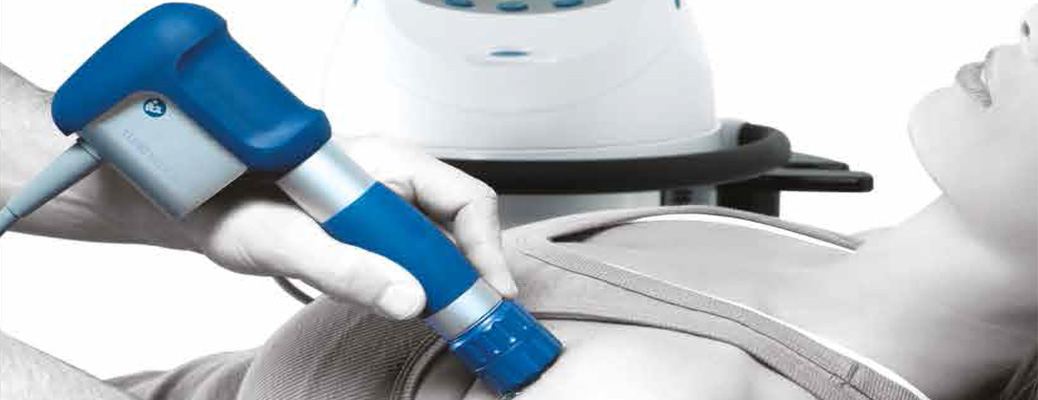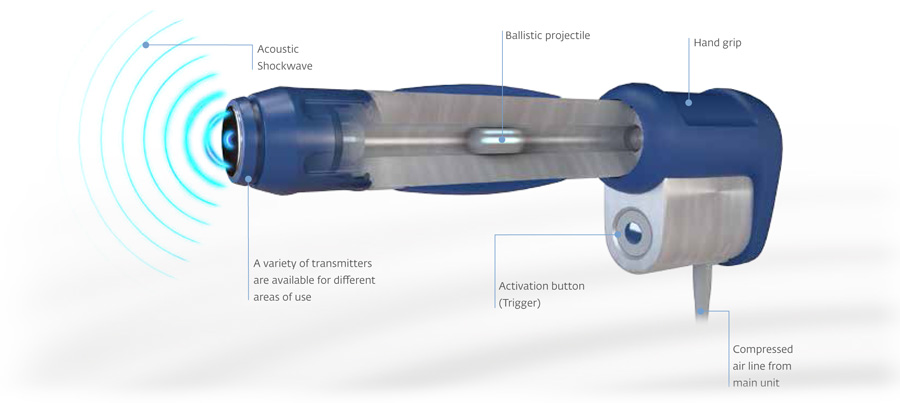
Radial Pressure Waves
Therapeutic shockwaves were introduced as a medical treatment for eliminating kidney stones without causing skin injury, over 20 years ago. Some of the side effects discovered while using this treatment, were the bone healing and accelerated tissue healing results on the areas submitted to shockwave treatment. Today the use of radial shockwaves or Radial Pressures Waves (RPW) has been successfully extended to other therapeutic and wellness applications such as:
- Shoulder calcifications
- Insertional tendonitis
- Myofascial trigger points
- Muscle and connective tissue activation
Radial Pressure Waves is an excellent non invasive treatment method with very few negative side effects, for indications that are normally very difficult to treat. For these indications we now know that RPW is a treatment method that reduces pain as well as improves function and quality of life.
The shockwaves are generated with a precision ballistic mechanism in the hand piece which accelerates a projectile by compressed air. The motion and weight of the projectile produce kinetic energy which translates along with the transmitter into sound energy in the form of an acoustic wave. The acoustic wave is transmitted into the tissue via a coupling gel and collectively this is known as “Radial Pressure Wave Therapy”. The propagating acoustic waves functionally stimulate increased blood flow and metabolic activity within the cell.

Physical effects of Radial Pressure Waves
Radial pressure waves offer a non invasive treatment solution for long term insertion and soft tissue pathologies. Local treatment of the affected area will enhance and reset the healing pattern.
Today there are several working hypotheses for the physical effects of radial pressure waves:
- Shockwaves create increased cell membrane permeability metabolically which allows old, damaged and weakened cells to be removed and replaced with healthy viable cells.
- And neurologically, Shockwaves produce a counter irritation at the dorsal root ganglion actually modulating the amount of nocioceptive activity and decreasing the pain signal and actually closing the theoretical pain gate.
- Vascular changes such as increased blood circulate in tissues which increases the oxygen content and significantly reduce the concentration of carbon dioxide in the tissue which may stimulate the healing process.
- Based on the hypothesis towards associative pain memory (Wess), afferent pain signals are transmitted through the central nervous system by multiple synaptic junctions which eventually cause efferent fibers to control muscle tone. The reflex mechanism works just like a regulatory circuit.
Will it work for me?
Radial pressure wave therapy is indicated for the following applications:
- Localizing and Deactivating Trigger Points: Triggers are localized at the low energy level (approximately 2 bar) by passing the transmitter over the muscle region being treated (increased sensitivity to pain) and then deactivated using a higher energy level(approximately 3 bar)
- Increasing Circulation: Promotes blood flow through the tissue and boosting metabolism
- Pulse Vibration Massage: Soothing relief from muscle strain and stress
- Plantar Fasciitis, Heel Pain, or Heel Spur: Plantar Fasciitis is an inflammatory condition of the foot caused by excessive wear to the plantar fascia that supports the arch
- Tendinosis Calcarea / Supraspinatus-Tendon: Shoulder calcifications and chronic shoulder pain
- Radial and Ulnar Humeral Epicondylitis: Tennis elbow, inflammation of tendon attachments on cubital or radial part of elbow joint (humeral)
- Achillodynia: Pain due to inflammation of Achilles tendon or the bursa associated with it
- Retropatellar Pain Syndrome: Pain in the front of and around the kneecap
- Tibial Edge Syndrome (“Shin Splints”): Pain located along or just behind the medial edge of the tibia
- Proximal Iliotibial Band (ITB) Friction Syndrome / Trochanteric Insertion Tendonitis: Pain or aching on the outer side of the knee or hip.
What are the Side Effects of Shockwave Therapy?
Side effects could occur after a treatment with Radial Pressure wave Therapy. The majority will appear after 1-2 days.
Common side effects include
- Reddening
- Swelling
- Pain
- Heamatoma (bruising)
- Petechia (red spots)
These side effects usually abate after 3-5 days
See how it works
Shockwave Therapy for Shoulder Pain
Shockwave Therapy for Lower Back Pain
Shockwave Therapy for Knee Pain
Shockwave Therapy for Plantar Fasciitis
